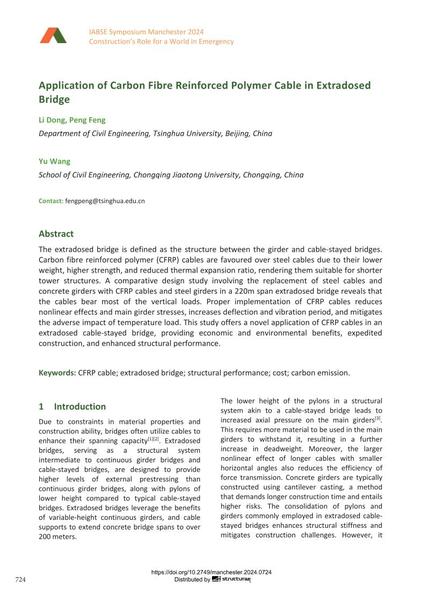Application of Carbon Fibre Reinforced Polymer Cable in Extradosed Bridge

|
|
|||||||||||
Détails bibliographiques
| Auteur(s): |
Li Dong
(Department of Civil Engineering, Tsinghua University, Beijing, China)
Peng Feng (Department of Civil Engineering, Tsinghua University, Beijing, China) Yu Wang (School of Civil Engineering, Chongqing Jiaotong University, Chongqing, China) |
||||
|---|---|---|---|---|---|
| Médium: | papier de conférence | ||||
| Langue(s): | anglais | ||||
| Conférence: | IABSE Symposium: Construction’s Role for a World in Emergency, Manchester, United Kingdom, 10-14 April 2024 | ||||
| Publié dans: | IABSE Symposium Manchester 2024 | ||||
|
|||||
| Page(s): | 724-729 | ||||
| Nombre total de pages (du PDF): | 6 | ||||
| DOI: | 10.2749/manchester.2024.0724 | ||||
| Abstrait: |
The extradosed bridge is defined as the structure between the girder and cable-stayed bridges. Carbon fibre reinforced polymer (CFRP) cables are favoured over steel cables due to their lower weight, higher strength, and reduced thermal expansion ratio, rendering them suitable for shorter tower structures. A comparative design study involving the replacement of steel cables and concrete girders with CFRP cables and steel girders in a 220m span extradosed bridge reveals that the cables bear most of the vertical loads. Proper implementation of CFRP cables reduces nonlinear effects and main girder stresses, increases deflection and vibration period, and mitigates the adverse impact of temperature load. This study offers a novel application of CFRP cables in an extradosed cable-stayed bridge, providing economic and environmental benefits, expedited construction, and enhanced structural performance. |
||||
| Mots-clé: |
pont extradossé
|
||||

